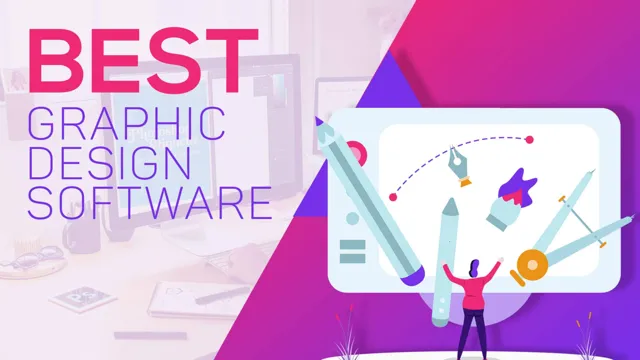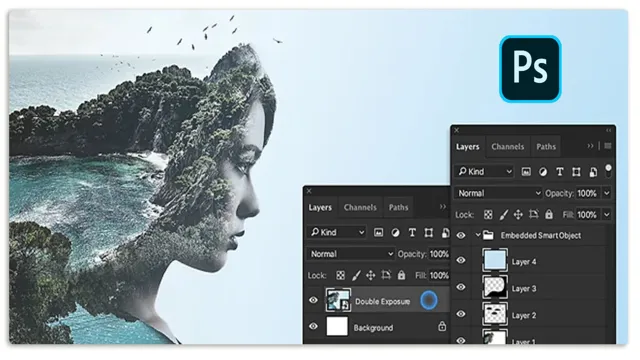Are you trying to find the right graphic design software for your needs? With so many options available, it can be overwhelming trying to choose the best one. But fear not, we’ve got you covered! In this article, we’ll be exploring the top graphic design software options on the market today. Whether you’re a professional graphic designer or just starting out, there’s something here for everyone.
We’ll be looking at each program’s features and capabilities so you can make an informed decision on which one is right for you. So grab a cup of coffee and let’s dive in!
Top 5 Graphic Design Softwares
Graphic design is an essential aspect of modern-day marketing and branding, and finding the perfect software can be tricky. Here are the top 5 best graphic design software for beginners and professionals alike. Adobe Creative Suite, which includes Photoshop, Illustrator, and InDesign, remains the most popular graphic design software because of its versatility and ease of use.
CorelDRAW Graphics Suite is another popular choice that packs a punch with its advanced editing tools and vector graphics capabilities. Sketch, a vector-based tool designed specifically for Mac users, offers an intuitive interface and is perfect for web design. Affinity Designer is a powerful vector design software that delivers impressive speed, performance, and precision.
Finally, Canva’s web-based platform offers a wide range of design tools for social media and marketing graphics, with a simple drag-and-drop interface. No matter which software you choose, the key is to find the one that works best for you and your specific needs.
1. Adobe Illustrator
Graphic design is an essential part of marketing and branding for businesses and individuals alike. Employing software that can bring your creative ideas to life is crucial, and Adobe Illustrator is undoubtedly one of the best tools for this job. Adobe Illustrator is a vector graphics editor that allows designers to create logos, illustrations, visuals, and typography for print, web, video, and mobile.
This software is capable of creating incredibly intricate designs and allows users to work with a wide variety of color palettes, gradients, and patterns. The user interface is intuitive and includes a variety of tools for transforming and manipulating shapes, text, and images. Notably, Adobe Illustrator also includes powerful tools for exporting designs to various file types, making it easy to share them with clients or collaborators.
All in all, Adobe Illustrator is an excellent choice for those looking for a professional yet user-friendly software to bring their creative visions to life.

2. Sketch
Sketch is a popular graphic design software that has become a favorite among designers due to its ease of use, powerful features and sleek design. Sketch is a vector-based design tool that makes it easy to create graphics for websites, mobile apps, and other digital platforms. The software is especially useful for designing user interfaces, icons, and logos.
Sketch features an intuitive interface that makes it easy to organize your work and access important tools and features. One of the best things about Sketch is the plugin ecosystem, which gives designers the ability to extend the functionality of the software with third-party plugins. Overall, Sketch is a great choice for designers who want a modern and sleek design tool that is both powerful and easy to use.
3. CorelDRAW
CorelDRAW When it comes to graphic design software, CorelDRAW is one of the most popular choices out there. With its powerful tools and versatile features, CorelDRAW is a must-have for any designer looking to create stunning graphics and artwork. Whether you’re creating logos, layouts, or illustrations, CorelDRAW has everything you need to bring your designs to life.
Its intuitive interface makes it easy to use even for beginners, while its advanced features allow for more advanced techniques and effects. One of the key benefits of CorelDRAW is its wide range of file formats, making it easy to export your designs to various platforms and devices. So if you’re a graphic designer looking for a reliable and effective tool, CorelDRAW is definitely worth considering.
4. Affinity Designer
Affinity Designer is one of the top 5 graphic design software available in the market. It’s a powerful tool that offers professional-level features for designers at an affordable price. The software is also designed to work seamlessly on both Mac and Windows platforms.
Users can create vector graphics, branding, marketing materials, UI designs, and illustrations with ease on Affinity Designer. The software has a user-friendly interface that makes it easy to use. Affinity Designer also offers a wide range of customization options, making it the perfect tool for creative professionals who need to complete challenging design projects.
If you’re looking for a software that consistently delivers high-quality results, Affinity Designer is a worthy investment.
5. Gravit Designer
Gravit Designer is one of the most feature-rich and lightweight graphic design software available today, making it a popular choice among designers of all skill levels. This software is designed to create vector graphics, web and app design, and illustrations quickly and easily. It offers a range of useful features like path graphs, pen tool, and customizable templates and styles that make it easy to create stunning designs without any hassle.
Additionally, it is user-friendly and straightforward to use, even for beginners. Its cloud-based system enables users to access their work from anywhere, making it an excellent choice for collaborative work. The most significant advantage of Gravit Designer is that it is free and open-source, making it an excellent option for those on a budget.
With its intuitive interface, versatile features, and affordability, Gravit Designer has earned its place in the top five graphic design software list.
Factors to consider before choosing a Graphic Design Software
When it comes to choosing the best graphic design software, there are several factors that you need to consider to ensure that you make the right choice. One of the most important factors is the type of design work you will be doing. If you primarily create vector graphics, then a software like Adobe Illustrator would be most suitable for you.
On the other hand, if you mainly work with photos and imagery, then Adobe Photoshop would be a better option. Another factor to consider is the level of experience you have with graphic design software. If you’re a beginner, you might want to start with a simpler software like Canva or Figma before moving on to more complex software like Sketch or Adobe InDesign.
Lastly, it’s important to consider your budget. Some software, like Adobe’s Creative Suite, can be quite expensive. However, there are also several free and open-source options available like GIMP and Inkscape.
By considering these factors, you can choose the best graphic design software that perfectly fits your needs and budget.
1. Price
When it comes to choosing a graphic design software, price is a significant factor to consider. Before investing in any software, it’s essential to ensure that it aligns with your budget. While some software may cost more, there may be options with fewer features that are more affordable.
Consider what features and tools are essential for your design needs, and compare prices among different software options. It’s important to note that some software may require annual subscriptions for updates and upgrades, so be sure to factor that into your decision-making process. Additionally, keep in mind that investing in more expensive software now could save you money in the long run by providing more comprehensive tools and features.
Ultimately, it’s about finding the balance between price and value that suits your needs and budget.
2. Compatibility
When it comes to choosing a graphic design software, compatibility is a crucial factor to consider. You need to ensure that the software you choose is compatible with your computer’s operating system, processor, graphics card, and RAM. A software that runs smoothly on a Windows computer may not function as well on a Mac.
Additionally, if you plan on collaborating with others, you need to choose software that is compatible with the others’ software and file formats. Compatibility issues can cause frustrating glitches and delays, which is why it’s essential to do your research and choose a software that suits your needs. Make sure that the graphic design software you choose is not only compatible with your hardware and software but also with the tasks you plan on completing.
3. Features and Tools
When choosing a graphic design software, it’s important to consider features and tools that will best suit your needs. Some factors to keep in mind are the level of customization offered, ease of use, variety of templates and designs, and compatibility with other software. If you’re an experienced designer looking for more control over every aspect of your project, you may want to choose a software with advanced tools and features such as vector editing, layer management, and typography controls.
On the other hand, if you’re just getting started with graphic design, a software with pre-made templates and a user-friendly interface may be easier to navigate and work with. It’s also important to consider the cost and whether the software fits within your budget. Keep in mind that some software offers free trials or freemium models to test out before committing to a purchase.
In the end, the best graphic design software for you will depend on your unique needs and preferences.
4. User-Friendliness
When choosing a graphic design software, it’s important to consider the user-friendliness factor. This means that the software should be easy to use and navigate, even for beginners. A good graphic design software should have an intuitive interface with clear and easy-to-understand tools and features.
This will save you a lot of time and frustration as you create your designs. Furthermore, the software should offer helpful tutorials and resources to help users learn the software and improve their design skills. The user-friendliness factor should never be underestimated as it can greatly impact your productivity and the quality of your designs.
So when looking for a graphic design software, prioritize those that are user-friendly and offer ample support resources.
Conclusion: Choose the Best Graphic Design Software for You
In the world of graphic design, choosing the best software is like selecting the perfect spice for a dish. Just as the right spice can elevate a meal, the best graphic design software can enhance your creativity and bring your visions to life. With a variety of options available, it’s important to consider your needs and personal style when making your choice.
Whether you prefer the versatility of Adobe Creative Suite, the intuitive simplicity of Canva, or the affordability of Affinity Designer, the best graphic design software is the one that allows you to create with confidence and have fun doing it. So go ahead, spice up your next project with the right software and let your creativity soar!”
FAQs
What are some examples of the best graphic design software?
Some examples of the best graphic design software include Adobe Photoshop, Illustrator, and InDesign, CorelDraw, and Sketch.
What should I consider when choosing the best graphic design software?
When choosing the best graphic design software, consider your needs, budget, and level of experience. Also think about the features and tools you need to create the type of designs you want.
Can I use free graphic design software?
Yes, there are some free graphic design software options such as GIMP and Canva, but they may not have as many features as paid software and may have limitations in their capabilities.
How much can I expect to spend on the best graphic design software?
The cost of graphic design software varies depending on the software and the subscription plan. Some software may have a one-time purchase fee while others may require a monthly or yearly subscription. Prices can range from a few hundred dollars to several thousand dollars depending on the software and plan chosen.
